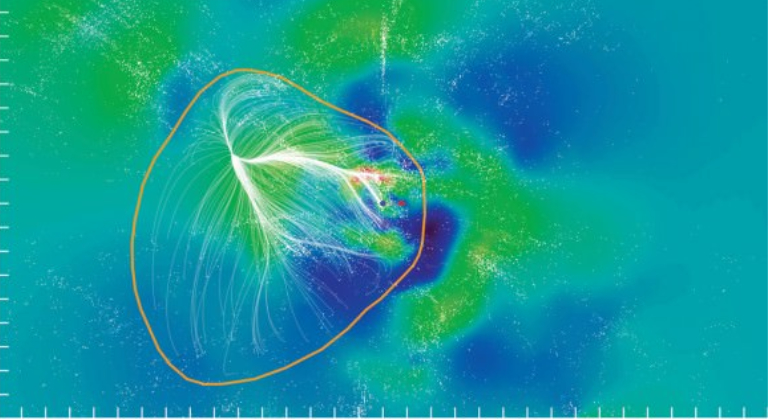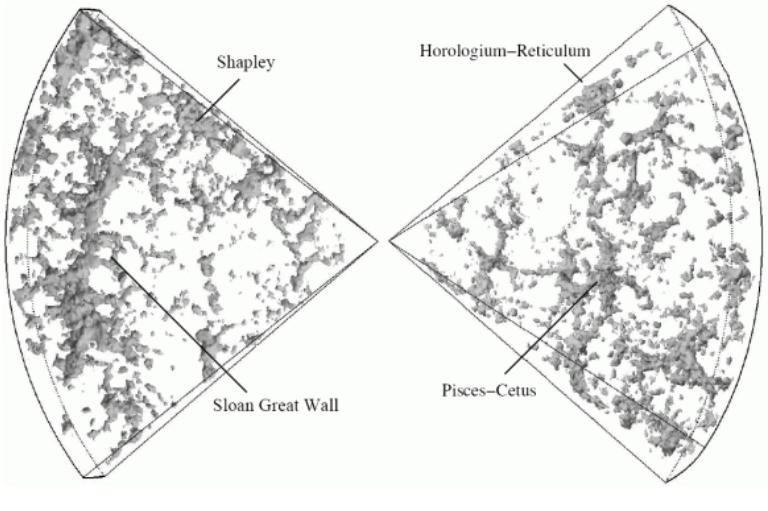If you want to determine your location in the universe, start with your cosmic address. You live in Earth-> Solar System-> Milky Way-> Local Cluster-> Spire Cluster-> Spire Supercluster-> Laniakia.
Thanks to new deep-sky surveys, astronomers now think all those places are part of an even larger cosmic structure in a “neighborhood” called the Shapley focus.
Astronomers refer to the Shepley concentration as a “gravitational basin”. It is an area full of mass that acts as an attraction. This region contains many clusters and groups of galaxies and has the highest concentration of matter in the local universe. All those galaxies, plus dark matter, exert their gravitational influence on the focus.
There are many such basins in the cosmos, including Laniakea. Astronomers are studying them more closely, which could help provide a more detailed map of the universe’s largest structures.

A team led by astronomer R. Brent Tully of the University of Hawaii measured the motions of about 56,000 galaxies to understand these basins and their distribution in space.
“Our universe is like a giant network, with galaxies running along filaments and clustered at nodes where gravitational forces pull them together,” Talley said.
Just as water flows in basins of water, galaxies also flow in basins of cosmic gravity. The discovery of these larger basins could fundamentally change our understanding of cosmic structure.
Cosmic currents and mapping structures
Tully’s team is called CosmicFlows and they study the motions of those distant galaxies in space. The team’s redshift investigations revealed a possible change in the size and scale of our local galactic basin of gravity.
We already know that we live in Laniakea, which is about 500 million light years across. However, the motions of the other clusters indicate that there is a larger attraction driving the cluster flow.
CosmicFlows data suggests that we could be a fraction of the Shapley concentration, which could be 10 times the volume of Laniakea. This is about half the volume of the largest structure in space. Known as the Great Wallwhich is a string of galaxies that extends within 1.4 billion light years.

The Shapley concentration was first observed by astronomer Harlow Shapley in the 1930s as a cloud in the constellation Centaurus. This supercluster appears along the direction of motion of the local group of galaxies (where we live). Because of this, scientists speculated that it could affect the strange motion of our galaxy.
Interestingly, the Virgo supercluster (and the Local Group and the Milky Way) appear to be moving towards the Shapley focus. The research Talley and others are doing should confirm this move toward whatever attracts them.
Exploring the larger structures in the universe
Where do these gravity pools come from? In a sense, they are as old as the universe and the cosmic web of matter that Talley refers to. The seeds of the web and those fascinating basins were planted about 13.8 billion years ago.
After the big bang, the baby universe was in a hot dense state. As it expanded and cooled, the density of matter began to fluctuate. There were small differences in those density fluctuations. Think of them as the first “seeds” of galaxies, galaxy clusters, and even larger structures that we see in the universe today.
As astronomers survey the sky, they find evidence for all those different structures. Now they have to explain. The idea that the Shapley concentration is the large basin to which our Laniakea belongs means that current cosmological models do not fully explain its existence.
“This discovery poses a challenge: Our cosmic surveys may not yet be large enough to map the full extent of these massive basins,” said UH astronomer Ehsan Korakchi.
“We still stare at giant eyes, but even these eyes may not be big enough to capture a complete picture of our universe.”
Measuring attractions
The main actor of all these galaxies, clusters and superclusters is gravity. The more mass, the more gravity affects the movements and distribution of matter.
For these attractive basins, Tully’s research team investigated their influence on the motion of galaxies in the region. These basins exert a kind of tug of war on the galaxies that lie between them. This affects their movements. In particular, redshift surveys like Tim Talley’s plot radial motion (along the line of sight), velocities (how fast they are moving), and other related motions.
By mapping the velocities of galaxies across our local universe, the team can define the region of space where each supercluster dominates.
Of course, these movements are difficult to define. That’s why the team does different types of measurements. They don’t just map the luminous material in galaxies. They also need to consider the existence of dark matter.
There are other complications as well. For example, not all galaxies are the same—that is, they differ in shape (morphology) and density of matter. Astronomers can do this by measuring something called the “galactic peculiar velocity.” This is the difference between its actual speed and the expected speed of the Hubble stream (which reflects gravitational interactions between galaxies).
The results of the Tully team’s investigations should provide more detailed 3D maps of these regions of space. This includes their structure as well as their movements and speed. These maps, in turn, should provide further insight into the distribution of all matter (including cold dark matter) across the universe.
This article was originally published by Universe Today. Read the original article.
#galaxy #collapse #huge #gravitational #basin #time